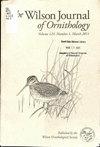社会环境对猪新恐惧行为的影响
IF 0.5
4区 生物学
Q4 ORNITHOLOGY
引用次数: 1
摘要
恐新症可能会减少动物对未知危险的暴露,但也会限制它们对潜在资源的探索。新事物恐惧症是一种人格特征,个体对新奇和具有挑战性的情况的行为反应总是不同的。人格研究人员通常在孤立的情况下测试受试者,这忽略了社会环境的潜在影响。我们使用一种典型的社会物种,灰山雀(Parus cinereus),比较了个体在非社会和社会背景下的新恐惧症行为反应。此外,我们还测试了具有相同和相反人格类型的同种个体对焦点个体行为的影响。我们发现,社会环境对灰山雀恐新行为的影响是基于其同种个体的个性:焦点个体在有同种个体时变得更大胆,害羞个体在与害羞同种个体配对时保持明显的害羞,害羞个体在与大胆同种个体配对时变得更大胆。研究结果表明,在社会环境中,个体在喂食器上的潜伏期较短,停留时间最长,这可以解释为同种个体的人格类型的影响。我们的研究结果表明,社会环境可以调节个体的个性表达。然而,为了更好地理解人格在社会环境中的功能作用,我们建议调查更大的社会群体中的互动动态,并评估他们的一些活动(例如,觅食、集体防御或捕食者躲避)的成本和收益。本文章由计算机程序翻译,如有差异,请以英文原文为准。
Influence of social context on Cinereous Tit (Parus cinereus) neophobic behavior
ABSTRACT Neophobia may offer benefits to animals by reducing their exposure to unknown dangers, but it can also limit their exploration of potential resources. Neophobia is a personality trait and individuals vary consistently in their behavioral response to novel and challenging situations. Personality researchers typically test subjects in isolation, which ignores the potential effects of the social environment. Using a model social species, the Cinereous Tit (Parus cinereus), we compared individual neophobic behavioral responses in asocial and social contexts. Further, we tested the influence of conspecifics with the same and opposite personality types on the focal individual's behavior. We found that social context influences the neophobic behavior of Cinereous Tits based on the personality of their conspecifics: the focal individual became bolder in the presence of bold conspecifics, the shy remained significantly shy when paired with shy conspecifics, and the shy became bold when paired with bold conspecifics. Our results showed in a social context individuals took shorter latency and spent maximum time at the feeder, which could be interpreted as the influence of conspecifics' personality types. Our results demonstrate that social context can mediate the expression of an individual personality. However, in order to better understand the functional role of personality in a social context, we recommend investigating interaction dynamics in larger social groups and assessing the costs and benefits of some of their activities (e.g., foraging, collective defense, or predator avoidance).
求助全文
通过发布文献求助,成功后即可免费获取论文全文。
去求助
来源期刊
CiteScore
0.90
自引率
0.00%
发文量
133
审稿时长
4-8 weeks
期刊介绍:
Aims & Scope
For more than a century, the Wilson Ornithological Society has published a scholarly journal with form and content readily accessible to both professional and amateur ornithologists. The Wilson Journal of Ornithology is a quarterly publication consisting of major articles based on original studies of birds and short communications that describe observations of particular interest. Each issue also includes reviews of new books on birds and related subjects, as well as ornithological news. Through an endowment from the late George Miksch Sutton, each issue of the Journal includes a full color frontispiece. Each current volume consists of approximately 500 pages. The principal focus of the Journal is the study of living birds, their behavior, ecology, adaptive physiology and conservation.
Although most articles originate from work conducted in the western hemisphere (a large portion of the research on Neotropical birds is published here), the geographic coverage of the journal is global. The Journal is internationally recognized as an important, major journal of ornithology. The Edwards Prize is given annually for the best major article published during the previous year.
The Wilson Journal of Ornithology was formerly named the Wilson Bulletin.

 求助内容:
求助内容: 应助结果提醒方式:
应助结果提醒方式:


